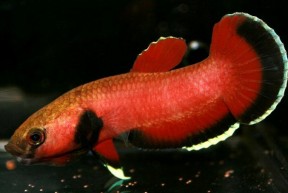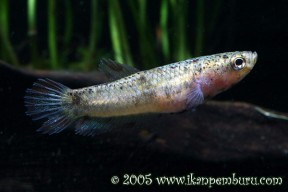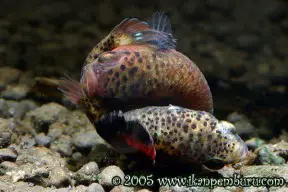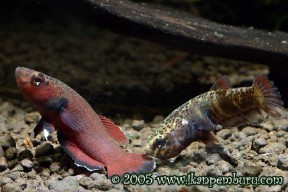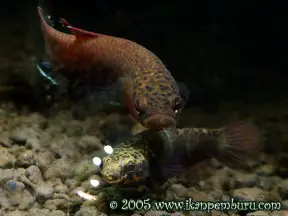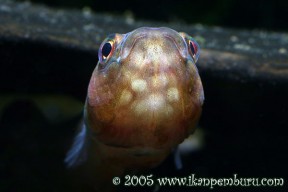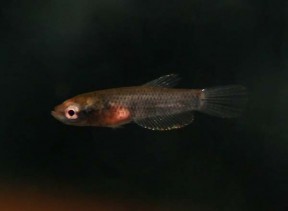Betta channoides
Snakehead Betta
Etymology
channoides: based on the generic name of the snakehead fishes, Channa, some species of which have the same head shape as B. channoides.
Classification
Order: Perciformes Family: Osphronemidae
Distribution
Native to the Mahakam river basin in the province of Kalimantan Timur (eastern Kalimantan) on the island of Borneo, Indonesia, with type locality ‘unnamed blackwater stream entering Mahakam River on the northern side near Mujub, 0°01’S, 115°43’E, Kalimantan Timur, Indonesia’.
The fish have been collected around Mujup, Sungai Merimun and Muarapahu with the most sought-after form originating from close to the village of Pampang.
Populations from the different localities are often labelled as such by collectors in order to maintain accuracy and preserve pure bloodlines.
Habitat
Inhabits shallow forest streams with brownish, acidic water, and is usually collected among leaf litter and marginal plant roots.
Maximum Standard Length
35 – 40 mm.
Aquarium SizeTop ↑
An aquarium with base measurements of 45 ∗ 30 cm could house a pair or small group.
Maintenance
Can be maintained in a fully-decorated aquarium although many breeders prefer not to use a substrate for ease of maintenance.
Driftwood roots and branches can be used and placed such a way that a few shady spots are formed while clay plant pots or lengths of piping can also be included to provide further shelter.
The addition of dried leaf litter further emphasises the natural feel and as well as offering additional cover for the fish brings with it the growth of microbe colonies as decomposition occurs.
These can provide a valuable secondary food source for fry and the tannins and other chemicals released by the decaying leaves are also considered beneficial for fishes from blackwater environments.
There is no need to use natural peat, however, the collection of which is both unsustainable and environmentally-destructive.
Like others in the genus this species seems to do best under fairly dim lighting.
You could add aquatic plant species that can survive under such conditions such as Microsorum, Taxiphyllum or Cryptocoryne spp., and a few patches of floating vegetation would be useful as well.
This species requires acidic conditions with negligible carbonate hardness and very low general hardness so a reverse osmosis unit or other method of obtaining soft water may need to be employed, and this can be further acidified using phosphoric acid or similar if necessary.
As it naturally inhabits sluggish waters filtration should not be too strong, with an air-powered sponge filter set to turn over gently adequate.
Keep the tank well-covered and do not fill it to the top as like all Betta spp. it requires occasional access to the layer of humid air that will form above the water surface, and is an excellent jumper.
Water Conditions
Temperature: 23 – 30 °C
pH: 4.0 – 6.5
Hardness: 18 – 90 ppm
Diet
Likely to prey on insects, other small invertebrates and zooplankton in nature.
Captive fish will normally accept dried products once they’re recognised as edible, but should be offered plenty of small live or frozen foods such as Daphnia, Artemia or bloodworm regularly to ensure development of optimal colour and condition.
Take care not to overfeed as Betta spp. seem particularly prone to obesity.
Behaviour and CompatibilityTop ↑
Not recommended for the standard community set-up for reasons already touched upon.
It’s requirements and disposition mean it’s best kept alone or with very small, peaceful species since much bigger or more vigorous fishes are likely to intimidate and outcompete it.
Some small cyprinids and loaches that inhabit similar environments in nature are compatible but proper research is essential.
It can be maintained in a pair or group and will display some interesting behavioural interactions under the latter circumstances.
Sexual Dimorphism
Adult males are more colourful and have a broader head shape than females.
Reproduction
Paternal mouthbrooder. Organise a separate tank for breeding purposes unless the fish are already being maintained alone, setting this up as suggested above.
The tank should have the tightest-fitting cover you can find (some breeders use clingfilm instead to ensure no gaps) as the fry need access to a layer of warm, humid air without which development of the labyrinth organ can be impaired.
Following a protracted courtship, eggs and milt are released during an ’embrace’ typical of anabantoids in which the male wraps his body around that of the female.
Several ‘dummy’ embraces may be required before spawning commences.
Fertilised eggs are caught on the anal fin of the male then picked up in the mouth of the female before being spat out into the water for the male to catch.
Once the male has all the eggs in his mouth the cycle is repeated untill the female is spent of eggs, a process which can take some time.
Brood size is quite small, with even 10 eggs being considered a good number.
A brooding male may swallow or release the eggs prematurely if stressed or inexperienced, so it’s preferable to leave the female and any other fishes in situ.
The incubation period is 10 – 21 days at the end of which the male will begin to release fully-formed, free-swimming fry.
At this point they can be removed or left to be reared alongside the adults, which will not normally harm them.
The fry are large enough to accept motile foods such as microworm and Artemia nauplii immediately, though it should be noted that there exist reports of young Betta developing health issues if fed excessive amounts of the latter.
Offer small amounts of different foods 2 -3 times per day for optimal growth rate, and don’t change too much water at once, with regular, small changes preferable to intermittent larger ones.
NotesTop ↑
B. channoides and B. albimarginata together comprise the Betta albimarginata group of closely-related species within the genus, these differing from all other members of the genus in colour pattern and by possession of 9-12 anal-fin spines vs. 0-4.
They look very similar to one another but differ in the following characters: anal fin spines 9-11 in B. albimarginata vs. 12 in B. channoides; anal fin rays 21-23 vs. 23-25; lateral scale rows 26-27 vs. 27.5-28; transverse scale rows 7.5 vs. 8.5; predorsal scales 6 + 7-8 vs. 7-8 + 8-9; predorsal length 65.2-61.7 vs. 59.8-63.5; dorsal fin insertion above 10-11th lateral scale row and 4-5th anal-fin spine vs. 12-13th and 5-7th.
Additonally, fin patterning in B. albimarginata, except the pectoral fins, consists of a broad white distal band, broad dark submarginal band with sharp outer margin and less sharp inner margin, and a plain red inner portion, while in B. channoides the dorsal fin is almost entirely red with only a thin white distal band and the dark submarginal band in the caudal fin does not extend into the uppermost portion of the fin.
Base body colouration tends towards a brick-red shade in displaying male B. albimarginata, scarlet in B. channoides.
The genus Betta is the most speciose within the family Osphronemidae with almost 70 recognised members and looks set to grow further with new ones continuing to be described on a regular basis since the turn of the century.
Member species have successfully adapted to inhabit a variety of ecological niches from stagnant ditches to flowing hill streams including some extreme environments such as highly acidic peat swamp forests.
The referral of members to a number of groups containing closely-related species is now generally accepted but largely based on morphological and behavioural characters.
Molecular phylogenetic work may therefore prove useful in more precisely determining relationships between these fishes.
A full list of the species groups as currently recognised can be found here.
Like others in the suborder Anabantoidei this species possesses an accessory breathing organ known as the labyrinth.
So-called due to its maze-like structure this organ allows the fish to breathe atmospheric air to a certain extent.
Comprising paired suprabranchial organs formed via expansion of the epibranchial (upper) section of the first gill arch and housed in a chamber above the gills, it contains many highly-vascularised, folded flaps of skin which function as a large respiratory surface.
Its structure varies in complexity between species, tending to be better-developed in those inhabiting harsher environments.
References
- Kottelat, M. and P. K. L. Ng, 1994 - Ichthyological Exploration of Freshwaters 5(1): 65-78
Diagnoses of five new species of fighting fishes from Banka and Borneo (Teleostei: Belontiidae). - Tan, H. H. and P. K. L. Ng, 2005 - Raffles Bulletin of Zoology Supplement 13: 115-138
The labyrinth fishes (Teleostei: Anabantoidei, Channoidei) of Sumatra, Indonesia. - Tan, H. H. and P. K. L. Ng, 2005 - Raffles Bulletin of Zoology Supplement 13: 43-99
The fighting fishes (Teleostei: Osphronemidae: Genus Betta) of Singapore, Malaysia and Brunei. - Tan, H. H. and P. K. L. Ng, 2006 - Ichthyological Exploration of Freshwaters 17(2): 97-114
Six new species of fighting fish (Teleostei: Osphronemidae: Betta) from Borneo.
